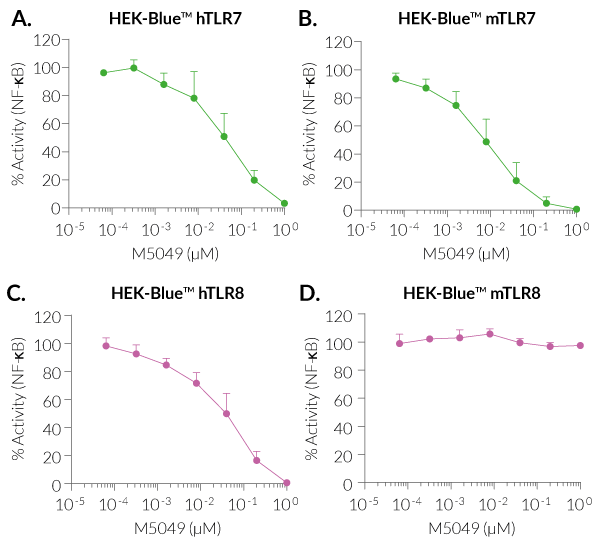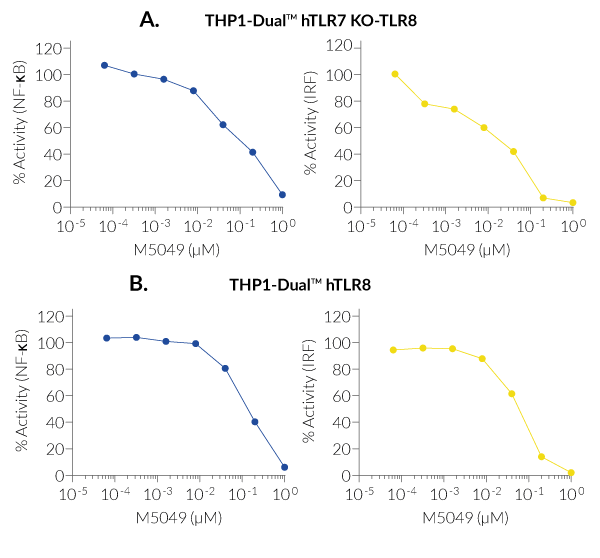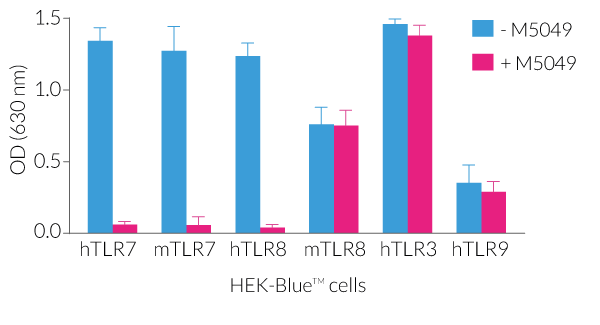M5049 (Enpatoran)
| Product | Unit size | Cat. code | Docs. | Qty. | Price | |
|---|---|---|---|---|---|---|
|
M5049 TLR7/TLR8 inhibitor - InvitroFit™ |
Show product |
5 mg 5 x 5 mg |
inh-m5049
|
|
Specific TLR7 and TLR8 dual inhibitor
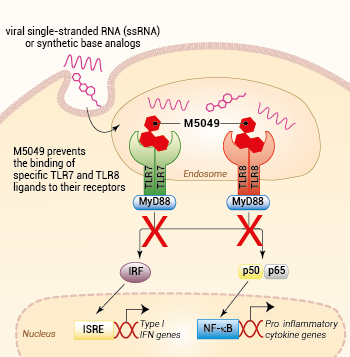
Inhibition of TLR7 and TLR8 signaling by M5049
M5049 (Enpatoran) is a quinoline-derivative that functions as a dual and selective inhibitor of TLR7 and TLR8 [1, 2]. Its potency has been demonstrated in various in vitro assays and a mouse lupus model in vivo [1, 2]. M5049 has been investigated as an oral treatment for systemic lupus erythematosus (SLE) and severe COVID-19 [3].
M5049 efficiently inhibits human (h)TLR7, mouse (m)TLR7, and hTLR8, but not mTLR8, as assessed using InvivoGen's HEK-Blue™ reporter cell lines overexpressing hTLR7, mTLR7, hTLR8, and mTLR8 (see figures).
M5049 exerts inhibitory actions on both NF-κB and IRF pathways downstream hTLR7 and hTLR8, as assessed with THP1-Dual™-derived cells (see figures).
Importantly, M5049 blocks the activation of TLR7 and TLR8 with no effect on other endosomal TLRs, i.e. TLR3 and TLR9 (see figures).
Mode of action
Structural studies have revealed that M5049 binds and stabilizes the hTLR8 dimer in its resting (inactive) state, antagonizing the binding of any TLR8 ligands [1, 2]. A similar mode of action has been suggested for TLR7 inhibition [2].
Key features of M5049
- Quinoline-derivative small molecule
- Dual and selective inhibitor of TLR7- and TLR8-mediated NF-κB and IRF pathways
- Potent inhibitor of human TLR7, human TLR8, and mouse TLR7
- No action on mouse TLR8 overexpressed in HEK-Blue™ cells
- M5049 acts as an antagonist that prevents the binding of TLR7 and TLR8 ligands to their receptors.
- InvitroFit™: each lot of M5049 is highly pure (≥95%) and functionally tested.
References:
1. Vlach J. et al., 2020. Discovery of M5049: a novel selective Toll-Like Receptor 7/8 inhibitor for treatment of autoimmunity. J Pharmacol Exp Ther. 376:397.
2. Zheng H. et al., 2023. Recent Advances on Small-Molecule Antagonists Targeting TLR7. Molecules 28 (2), pp.634. ff10.3390/molecules28020634ff. ffhal-04564284.
3. NCT04647708, NCT04448756, NCT05540327, NCT05162586. www.clinicaltrials.gov. As accessed in October 2024.
Specifications
CAS number: 2101938-42-3
Formula: C16H15F3N4
Molecular weight: 320.32 g/mol
Solubility: 62.4 mM (20 mg/ml) in H2O
Working concentration:
- in vitro: 40 nM - 1 μM for cellular assays, depending on cell type and agonist (see figures).
- in vivo: 0.1 mg/kg - 10 mg/kg, oral gavage, once daily, in BXSB-Yaa mouse model of lupus and 0.3 mg/kg - 10 mg/kg, oral gavage, once daily, in IFN-α accelerated NZB/W mouse model of lupus [1].
Quality control:
- Purity: ≥95% (UHPLC)
- The inhibition of human TLR7 by M5049 is confirmed using HEK-Blue™ hTLR7 cells.
- The absence of bacterial contamination (e.g. lipoproteins and endotoxins) has been confirmed using HEK-Blue™ hTLR2 and HEK-Blue™ hTLR4 cells.
Reference:
1. Vlach J. et al., 2020. Discovery of M5049: a novel selective Toll-Like Receptor 7/8 inhibitor for treatment of autoimmunity. J Pharmacol Exp Ther. 376:397.
Back to the topContents
M5049 (Enpatoran) is available in two quantities:
- inh-m5049: 5 mg
- inh-m5049-5: 25 mg (5 x 5 mg)
![]() M5049 is shipped at room temperature.
M5049 is shipped at room temperature.
![]() Upon receipt, store at -20 °C.
Upon receipt, store at -20 °C.
Details
TLR7 and TLR8 are both activated by single-stranded (ss)RNA and RNA molecules found in immune complexes with RNA protein-binding autoantibodies [1]. Thus, these two TLRs play a beneficial role in clearing microbial infections, but they can also contribute to the pathogenesis of autoimmune diseases such as cutaneous and systemic lupus erythematosus (CLE/SLE) [1-3]. In addition, it is postulated that TLR7/8 may play a role in the cytokine storm in severe coronavirus disease 2019 (COVID-19) pneumonia [2, 3].
M5049 is described as a dual TLR7/TLR8 inhibitor slightly more selective for TLR7 using in vitro cellular assays [1]. However, in-house data suggest that the in vitro potency for each inhibitor depends on the choice of TLR7/TLR8-expressing cell lines and the type of agonists.
M5049 is currently under investigation as an oral treatment for lupus and severe COVID-19 [3-6].
Chemical structure of M5049
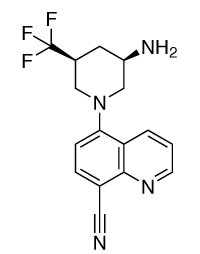
References:
1. Vlach J. et al., 2020. Discovery of M5049: a novel selective Toll-Like Receptor 7/8 inhibitor for treatment of autoimmunity. J Pharmacol Exp Ther. 376:397.
2. Port A. et al., 2021. Phase 1 study in healthy participants of the safety, pharmacokinectics, and pharmacodynamics of enpatoran (M5049), a dual antagonist of toll-like receptors 7 and 8. Pharmacol Res Perspect 9(5):e00842.
3. Klopp-Schulze I. et al. 2022. Applying Modeling and Simulations for Rational Dose Selection of Novel Toll-Like Receptor 7/8 Inhibitor Enpatoran for Indications of High Medical Need. Clin Pharmacol Ther, 112: 297-306.
4. NCT04647708, NCT04448756, NCT05540327, NCT05162586. www.clinicaltrials.gov. As accessed in October 2024.
5. Kalliokas. et al., 2021. Targeting TLR Signaling Cascades in Systemic Lupus Erythematosus and Rheumatoid Arthritis: An Update. Biomedicines 12(1):138.
6. Port A. et al., 2021. Phase 1 study in healthy particpants of the safety, pharmacokinectics, and pharmacodynamics of enpatoran (M5049), a dual antagonist of toll-like receptors 7 and 8. Pharmacol Res Perspect 9(5):e00842.






